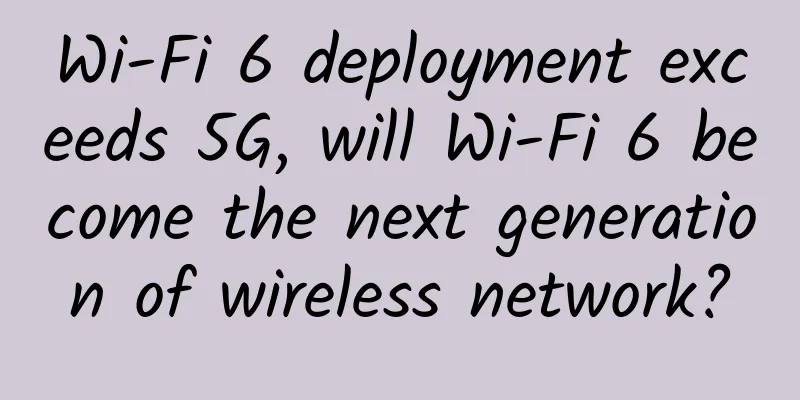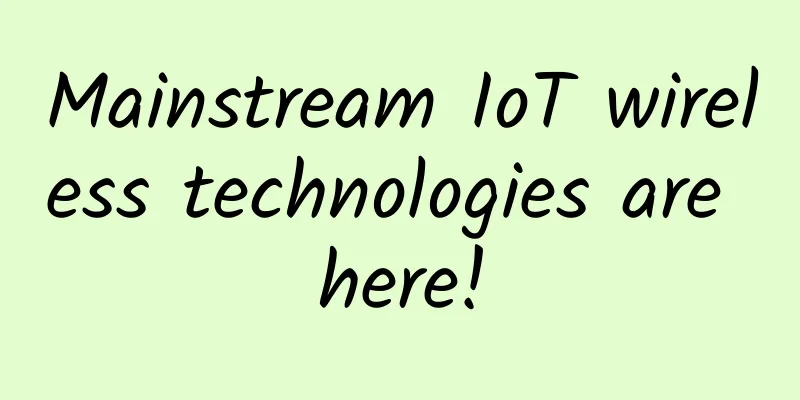Wi-Fi 6 deployment exceeds 5G, will Wi-Fi 6 become the next generation of wireless network?

|
In addition to popular devices such as smartphones, tablets, and PCs, Wi-Fi 6 will also be embedded in other devices, including wireless cameras, smart home devices, game consoles, wearable devices, and AR/VR headsets. So, will Wi-Fi 6 replace 5G and become the next generation of wireless networks? 1. What is the difference between Wi-Fi 6 and 5G?WiFi technology is a wireless local area network technology and is an extension of fixed network. In 2019, the WiFi Alliance renamed WiFi, defining them as WiFi 1 to WiFi 6 in order of their appearance. The WiFi 6 that is often mentioned now is IEEE802.11ax. WiFi 6 was launched at a similar time to 5G and is considered to be a technology of the same period as 5G. WiFi 6 can achieve a theoretical maximum access speed of 9.6Gbps, while the maximum speed of 5G is 10Gbps, and the speeds of the two are relatively close. Of course, this is an ideal situation. In actual use, the impact of the actual environment must also be considered. According to the current evaluations of various media, at the same megabit rate, the speed of 5G in the actual environment is approximately maintained at 500-700 Mbps due to interference issues such as the distance from the signal base station. Wi-Fi 6, on the other hand, can maintain a relatively stable speed of 800 Mbps because the signal transmission source is the router and we are often relatively close to the router. From the application scenario, 5G uses an ultra-high frequency spectrum, and the higher the frequency, the weaker the diffraction ability, that is, the ability to pass through obstacles will decrease as the frequency increases. Therefore, 5G signals are easily blocked by buildings and the indoor environment will significantly affect the speed of 5G, so 5G is usually used for devices that move across large geographical areas. Wi-Fi 6 is mainly used by routers, which are controlled by transmission power due to health and other factors. The coverage range of routers is generally around 90-120 square meters. Moreover, because it needs to be used through a router, it cannot be carried outdoors for free movement. If we are indoors and do not need to move around a large area, such as connections within homes and offices, Wi-Fi 6 is the preferred choice. 2. Wi-Fi 6 and 5G each have their placeIt is not difficult to find that both Wi-Fi 6 and 5G technologies can achieve higher speeds, lower latency, higher device density and network capacity, but they also have different complementary advantages. In 2021, Deloitte's global advanced wireless survey of 437 network executives from nine countries found that 45% of enterprises are simultaneously testing or deploying Wi-Fi 6 and 5G for their advanced wireless initiatives. Nearly all respondents (98%) said they expect to be using both technologies within three years, and these leaders, on average, expect to allocate 48% of their enterprise wireless network spending to Wi-Fi and 52% to cellular technologies. According to Deloitte, these decision makers already view Wi-Fi 6 and 5G as the most critical wireless technologies for their businesses. About 65% of networking respondents said they expect Wi-Fi 6 to be in the top three critical wireless technologies for their business by 2023, while 76% expect 5G to also be in the top three. Countries with the highest levels of Wi-Fi 6 pilots and deployments, such as Germany, Brazil, the United Kingdom, China, and Australia, also have the highest levels of 5G pilots and deployments, which Deloitte said shows that both technologies are being adopted simultaneously and have a place in advanced wireless plans. 3. Who will be the next generation of wireless networks?Wi-Fi 6 and 5G are wireless LAN technologies of the same period. The two are comparable in speed and differ only in usage scenarios. So which one, Wi-Fi 6 or 5G, will become the overlord of the next generation of wireless networks? In terms of application, according to Deloitte's research results, Wi-Fi 6 pilots and deployments have surpassed 5G in several countries and regions. One reason is cost. Wi-Fi 6 devices are more affordable and more widely available than 5G devices. Meanwhile, ease of deployment is another reason why Wi-Fi 6 is ahead. Wi-Fi networks are already widely established, and a large number of Wi-Fi devices are ready. As enterprises upgrade to Wi-Fi 6 networks, they can take advantage of forward compatibility and avoid replacing older Wi-Fi equipment all at once. Additionally, many enterprise IT departments already have expertise in deploying and operating Wi-Fi networks. In contrast, 5G is a new network technology that requires adapting to standards and protocols that are still being rolled out. Despite this, Wi-Fi 6 also has its limitations. In the 4G era, the main reason why WiFi failed to replace 4G is that its application scenarios are still limited to indoors and there is no way to achieve wide coverage like 4G. Similarly, compared with Wi-Fi 6, 5G has more support for wide area network devices - large-scale mobility of terminals and global roaming, which is something WiFi technology cannot do. In addition, since WiFi cannot ensure the security of devices, some devices with higher security requirements will not use WiFi for connection, such as some public facilities, industrial IoT equipment, etc. It’s worth noting that complementary use cases are already emerging for Wi-Fi 6 and 5G. Deloitte noted that unlike previous generations of wireless technology, Wi-Fi 6 and 5G are designed to work smoothly together, and the wireless industry is moving towards a future where devices can roam securely and seamlessly between all types of wireless networks. Industry associations and standards bodies are working together to develop future network standards that will enable the convergence of cellular and non-cellular technologies, integrating Wi-Fi 6 into core 5G networks. Expected benefits of this integrated architecture include improved traffic control on factory floors and the ability to provide uninterrupted services for smart city and edge applications. ConclusionOverall, in the early stages, Wi-Fi 6 and 5G will complement each other. During the development process of 5G, it is difficult for 5G base stations to achieve comprehensive coverage in the early stage. The operators' 5G construction mainly focuses on outdoor coverage, while taking into account some shallow indoor coverage. This means that indoor areas need to be supplemented by WiFi 6. In the later stage, whether 5G or WiFi 6 will gain the upper hand will depend on how the industrial chain develops and how operators make decisions. In terms of technology, 5G can replace WiFi 6, but WiFi 6 cannot replace 5G. |
>>: In the digital age, FONE comprehensive budgeting practice sharing in the pharmaceutical industry
Recommend
Huawei Enjoy 10S released with a 48-megapixel ultra-wide-angle AI triple camera priced at RMB 1,000. Are you tempted?
This afternoon, Huawei released a thousand-yuan m...
How to save records when surfing the Internet? You need to know the relationship between Session and Cookie
Why use Session and Cookie? In a nutshell, becaus...
[Black Friday] CloudCone: Los Angeles VPS from $16.79/year, Premium SC2 from $32.94/year
CloudCone's Black Friday promotion is in prog...
Customer-oriented, one-stop service empowers enterprises' digital transformation needs
From cross-border e-commerce to new energy vehicl...
It's not safe to talk to a teddy bear these days. The Chungking Express scene would be terrible if it happened now.
[51CTO.com original article] The classic scene in...
Black screen problem on some live IPTV channels under BRAS equipment
The telecom IPTV platform of a certain city found ...
Detailed roadmap for 5G standards
[[429204]] While 5G has been a hot topic for year...
Increase power, adjust location, and switch channels to speed up WiFi.
Have you adapted to your daily work and life afte...
ZJI: 30% off on Huawei/Kwaiwan dual-line servers in Hong Kong, special Huawei models in Hong Kong with a monthly discount of 300 yuan and starting at only 450 yuan/month
This year's New Year came earlier. After New ...
Wind River Wins Two Awards at 2017 SDN/NFV World Summit
At the 2017 SDN/NFV World Summit hosted by Layer1...
CDN price war ends, with Wangsu, Alibaba and Tencent taking over the market
[[239400]] Image source: Visual China The CDN pri...
Blockchain is the foundation, digital currency is the end
The concept of blockchain has become one of the h...
How does Spanning Tree Protocol prevent network loops and ensure security?
Spanning Tree Protocol (STP) is one of the key me...
Wireless Technology Review in 2016: 3.5 GHz Prompts New Changes in Spectrum Sharing
According to foreign media reports, in the past y...
Video and Network - Why is 700MHz the golden channel?
Labs Guide 700M is called the "golden freque...









